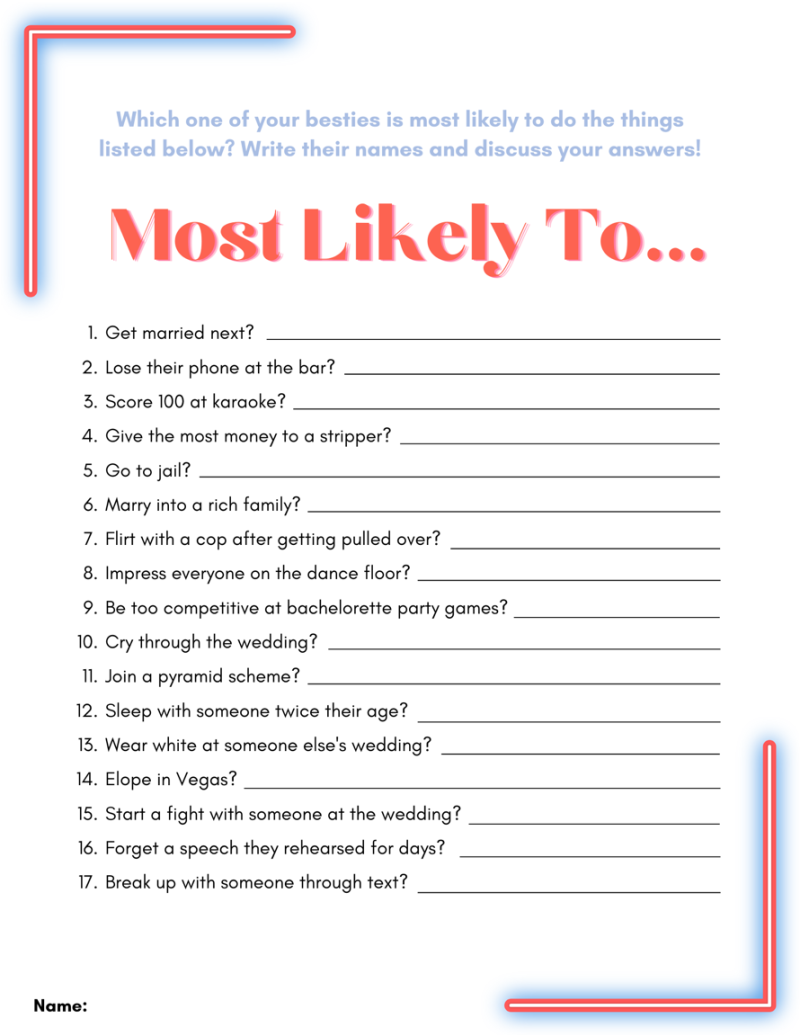Unraveling The Fun: A Dive Into Most Likely To Questions
In the realm of social interactions and games, "most likely to questions" serve as a delightful way to spark laughter, provoke thought, and encourage bonding among friends and acquaintances. These questions are not just a way to pass the time; they often reveal hidden truths, surprising insights, and even some light-hearted banter among participants. Whether at a party, a casual get-together, or a team-building event, these questions can create memorable moments that linger long after the gathering has ended.
As people engage in these playful inquiries, they get to know each other better, leading to deeper connections. The beauty of "most likely to questions" is that they can be customized to suit various occasions, from humorous to serious tones. The versatility of these questions makes them a favored choice among groups looking to break the ice or enhance their camaraderie.
In this article, we will explore the world of "most likely to questions," diving into their purpose, how to create your own, and some fantastic examples to get you started. Get ready to laugh, reminisce, and maybe even cringe a little as we uncover the intriguing dynamics of this entertaining pastime.
- Taylor Swift Grammy Awards 2013
- Nightmare On Elm Street Glen Lantz
- Where Is Chase Stokes From
- Capricorn And Scorpio Compatible
- Obama And Jennifer Aniston
What Are "Most Likely to Questions"?
"Most likely to questions" are prompts that ask participants to identify who in the group is most likely to engage in a specific behavior or action. These questions can range from light-hearted and funny to thought-provoking and insightful. The typical format involves a statement that begins with "Who is most likely to..." followed by a behavior or scenario, prompting participants to vote or discuss their answers.
How Do You Play "Most Likely to Questions"?
The game can be played in various settings, whether in large groups or intimate gatherings. Here’s a simple guide on how to play:
- Gather Participants: Assemble a group of friends, family, or colleagues.
- Prepare Questions: Compile a list of "most likely to questions" tailored to your group.
- Take Turns: Each participant takes turns asking a question, allowing everyone to respond.
- Discuss Answers: After responses, have a light discussion or share stories related to the answers given.
Why Are "Most Likely to Questions" So Popular?
The popularity of "most likely to questions" can be attributed to their ability to foster connection and create a fun atmosphere. They encourage participants to reflect on their knowledge of one another, leading to laughter and shared experiences. Moreover, these questions can serve as a great icebreaker, especially in new social settings where participants may not know each other well.
- A Philly Special Christmas
- Mary Kay Letourneau Husband Now
- What Season Does Bobby Die
- What Celebrity Has Died Recently
- Who Is Khloes Father
What Are Some Examples of "Most Likely to Questions"?
Here are a few examples to illustrate the variety of "most likely to questions" you can use:
- Who is most likely to become a millionaire?
- Who is most likely to go skydiving?
- Who is most likely to forget their best friend's birthday?
- Who is most likely to start a viral TikTok trend?
- Who is most likely to adopt a pet on impulse?
- Who is most likely to travel the world?
How Can You Customize "Most Likely to Questions" for Your Group?
Customizing "most likely to questions" can make the game even more enjoyable. Consider the interests, experiences, and personalities of your group. Here are some tips for crafting tailored questions:
- Reflect on Shared Experiences: Use inside jokes or memorable moments from past gatherings.
- Consider Personal Interests: Tailor questions to hobbies or passions of group members.
- Mix Humor with Seriousness: Balance funny questions with more thoughtful ones to engage everyone.
Can "Most Likely to Questions" Be Used in Professional Settings?
Absolutely! "Most likely to questions" can be a great addition to team-building exercises in professional environments. They can help break down barriers and encourage open communication among colleagues. When used effectively, these questions can promote trust and camaraderie within a team, making them more cohesive.
Who Is Most Likely to Excel at "Most Likely to Questions"?
While anyone can participate in "most likely to questions," some individuals naturally shine in these scenarios. Typically, those with a good sense of humor, strong social skills, and a genuine interest in others tend to excel. They can weave in personal anecdotes, draw laughter from the group, and create a fun atmosphere. These individuals often become the life of the party, engendering a sense of comfort that encourages participation from everyone.
How Can You Encourage Participation in "Most Likely to Questions"?
Getting everyone engaged can sometimes be a challenge, but here are some strategies to encourage participation:
- Create a Welcoming Environment: Ensure everyone feels comfortable sharing their thoughts without fear of judgment.
- Lead by Example: Start with a fun question and share your answer to set the tone.
- Incorporate Prizes: Consider small rewards for participation to motivate shy individuals.
Are There Any Notable Figures Associated with "Most Likely to Questions"?
While "most likely to questions" are a common social game, they have appeared in various media, including talk shows and reality TV. Celebrities often engage in similar questioning games during interviews or as part of games on social platforms. This has contributed to the popularity of the game, allowing fans to connect with their favorite stars through laughter and shared experiences.
Conclusion: Why You Should Embrace "Most Likely to Questions"
In conclusion, "most likely to questions" provide a platform for laughter, bonding, and revelations among friends and acquaintances. Their versatility and ability to adapt to various social settings make them a timeless choice for gatherings. So, the next time you find yourself in a social event, consider incorporating these fun questions to break the ice and create lasting memories. After all, who knows what surprising truths and funny stories might emerge from a simple game of "most likely to questions"?
Article Recommendations
- Father In American Pie
- Mary Kay Letourneau Husband Now
- Hocus Pocus The Rise Of The Sandersons
- Phil Collins Youll Be In My Heart
- Lin Manuel Miranda Percy Jackson



Detail Author:
- Name : Elda Roob
- Username : grady.alba
- Email : allie.greenfelder@gmail.com
- Birthdate : 1975-04-11
- Address : 16736 Romaguera Passage New Larue, RI 70905
- Phone : +1.813.824.8496
- Company : Hackett-Dietrich
- Job : Bartender
- Bio : Esse soluta eveniet veniam. Aut voluptatibus dolore aliquid corrupti perspiciatis doloremque. Qui qui fugit exercitationem ipsum officia.
Socials
tiktok:
- url : https://tiktok.com/@noland
- username : noland
- bio : Aperiam officia voluptatibus voluptatem sit doloribus.
- followers : 5723
- following : 1805
instagram:
- url : https://instagram.com/duncan.nolan
- username : duncan.nolan
- bio : Beatae non optio vel. Quas rerum omnis corporis placeat mollitia aliquid nihil iusto.
- followers : 5853
- following : 1356